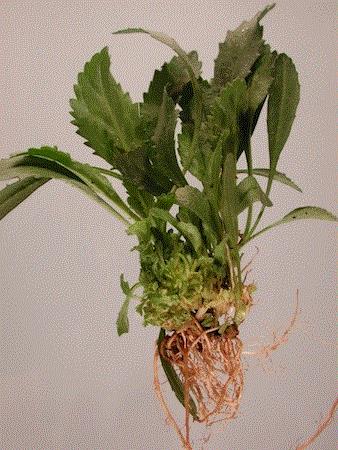Seed Your Future
With labor shortages in our industry and fewer students pursuing degrees in horticulture, I wanted to take a moment to remind you of the efforts of Seed Your Future. This program aims to improve awareness of horticulture in the U.S. and to promote horticulture as a viable career path for the nation's youth.
The www.seedyourfuture.org website is full of daunting facts, such as "61% is the percentage of open jobs in horticulture filled annually—causing severe workforce gaps." Or how about this one: "0% of middle schoolers in our focus groups said they have heard the word 'horticulture.'"
The Seed Your Future initiative aims to create a favorable perception of horticulture and horticultural careers among youth and youth influencers (that's us). These efforts will increase the skilled workforce in horticulture and develop a strong pipeline of future talent.

Download a copy of Seed Your Future's infographic detailing the challenges, progress and opportunities in horticulture: The Future of Horticulture: Inspiring the Love of Plants and Plant Careers.
Please visit the Seed Your Future website to learn more about this initiative and how you can support their efforts of keeping horticulture relevant with today's youth.

Bloom!

Click here to download a copy of the Surprising World of Horticulture infographic.
Bloom! is Seed Your Future's first campaign to promote horticulture and horticultural careers. Bloom! is a movement to improve the world through the power of plants. The first audience being targeted is middle schoolers; next year the efforts will focus on colleges and universities.
The www.WeAreBloom.org website is full of tools and resources, including lesson plans, activities and online learning modules for adults working with youth.

The website is both fun and informative. I took the online "Find Your Plant Power" quiz and learned that I'm a Guardian. What's your power? You'll have to take the quiz to find out.
I enjoyed taking the quiz, watching short informative videos like the one above and learning how to inspire today's youth. Be sure to visit www.WeAreBloom.org to learn your power and discover the incredible power and potential plants have to change the world.

Coreopsis Sizzle & Spice Hot Paprika

www.waltersgardens.com
Although it's the holiday season and this coreopsis has rich, deep red flowers, I'm not promoting it for winter sales. Rather, I wanted to bring this rising star to your attention (perhaps for Christmas in July). Coreopsis verticillata Hot Paprika from Walters Gardens is a very showy threadleaf coreopsis that has a compact, rounded habit that's completely covered with 1.5-in. flowers from early to late summer. Hardy to Zone 4.
Scabiosa Reveal
In the last newsletter, I showed the images of scabiosa above. These images were sent to me by a fellow subscriber asking for our help to determine what could possibly be causing the symptoms they see on their crops.
Several subscribers were up to this diagnostic challenge. The answers I received were: aster yellows; a response to day length/light intensity; broad mites/Eriophyid mites; high fertility levels; over-application of plant growth regulators; Rhodococcus; a virus; and water stress. These were all great responses to this challenge. The good news is several of the replies I received were correct. Are you ready for the answer?
Diagnostic results from Oregon State University confirmed these scabiosa were infected with Rhodococcus fascians. Rhodococcus (aka leafy gall) is a bacterium that's characterized by the formation of masses of short, thick and aborted stems with misshapen leaves often located near the soil line of the plant, but may be observed in the leaf axils in some cases.
Congrats to everyone who nailed it. You earned yourself a big gold star. I'd like to thank all those who responded and played a role in helping a fellow grower out. Perennial Pulse subscribers are the BEST!

Dealing with Leafy Gall

Rhodococcus on Leucanthemum (Oregon State University)
Before I get into management strategies, I'd like to give a shout out to Oregon State University's Plant Clinic who've become the go-to place for research, diagnostics and information on Rhodococcus. The OSU website (plant-clinic.bpp.oregonstate.edu/rhodococcus) is loaded with tons of information and images of this disease. If I suspect a client of mine has this bacterium, I (without hesitation) send samples to OSU for diagnosis.
There are over 70 genera (many of them are perennials) that have been observed with Rhodococcus. I commonly see this bacterium on gaillardia, heuchera, leucanthemum and veronica. Other susceptible perennials include aster, campanula, erysimum, phlox and viola.
R. fascians grows on the surface of the plants, often without causing symptoms for quite some time. At some point, the bacterium moves inside the plant; symptoms are triggered when this occurs. It's commonly spread during propagation, on tools such as scissors or trimming shears, with splashing water and in flood irrigation systems.
Unfortunately, there's no cure for Rhodococcus. Plants showing symptoms should be discarded. There are several preventative steps you can take to minimize the spread and severity of R. fascians. Consider the following measures:
-
Clean and sanitize the production area between crops or before introducing new plant materials
-
Start with pathogen-free plants
-
Inspect all incoming materials before placing them in the greenhouse
-
Minimize overhead irrigation or the amount of time the foliage remains wet; keep the foliage as dry as possible
-
Do not take cuttings or trim the plants when the foliage is wet
-
Increase the air circulation around plants prone to Rhodococcus (wide spacings and HAF fans)
-
Routinely disinfect propagation knives, scissors and trimming equipment
-
Apply disinfectants to susceptible crops following any activity, such as potting, spacing, tagging or trimming
-
Discard any plants showing symptoms—never take cuttings from them
Click here for a great article on Rhodococcus fascians from OSU.

Happy Holidays!
From my family to yours ...

... wishing you a wonderful holiday season.
Thanks for reading this edition of Perennial Pulse. Feel free to drop me a line with any questions or article ideas you may have. You can also send me a quick "hello" anytime. I'd love to hear from you.
My email is ppilon@ballpublishing.com.
Have a safe holiday season.
Paul Pilon
Editor-at-Large
Perennial Pulse
This email was received by you and over 33,902 subscribers!
If you're interested in advertising in Perennial Pulse, contact Kim Brown ASAP and she'll hook you up.